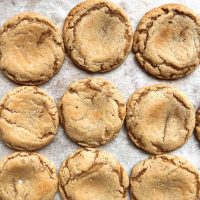
Perfectly Chewy Chocolate Chipless Cookies
These chocolate chipless cookies have perfectly crisp edges and a thick, gooey center! Dark brown sugar and a good dose of vanilla give them rich, caramel notes.
Servings 20 cookies
Equipment
Ingredients
- 2 cups [284 g] all-purpose flour
- 1 teaspoon baking powder
- 1/2 teaspoon baking soda
- 9 tablespoons unsalted butter, at room temperature
- 3/4 cup [150 g] granulated sugar
- 3/4 cup [150 g] dark brown sugar (light will work, but I prefer the rich, caramel notes of dark brown)
- 3/4 teaspoon fine salt
- 1 large egg
- 1 large egg yolk
- 1 tablespon pure vanilla extract
- Flaky salt, for sprinkling, optional
Instructions
- Adjust an oven rack to the middle of the oven. Preheat the oven to 400F [200C]. Line two sheet pans with parchment paper.
- In a medium bowl, whisk together the flour, baking powder, and baking soda.
- In the bowl of a stand mixer fitted with a paddle, beat the butter on medium speed until creamy, about 1 minute. Add the granulated and brown sugars and salt and beat on medium speed until light and fluffy, 2 to 3 minutes. Scrape down the sides of the bowl, add the egg, yolk, and vanilla, and mix until smooth. Add the flour mixture and beat on low speed until just combined. Use a rubber spatula to give the dough a final mix and make sure it is completely combined.
- Form the dough into balls, about 2 tablespoons each [50 g], and place the dough on one of the prepared sheet pans. Place the pan in the freezer until the dough is firm, about 20 minutes.
- When the dough is chilled, place 8 cookies on each sheet pan. Sprinkle each cookie with a little flaky salt, if desired.
- Bake one pan at a time, rotating halfway through baking. Bake the cookies until the tops are golden brown and the cookies are slightly puffed 8 to 11 minutes. Remove the baking sheet from the oven and use the back of a spoon to gently press the center of each cookie. Let the cookies rest on the sheet pan for 5 minutes, then transfer them to a wire rack to finish cooling. Cookies are best slightly warm but can be stored in an airtight container at room temperature for up to three days.
- Cookies will soften the longer they sit. Cookie dough can be formed and refrigerated overnight, then baked the next day; the cookies may need an extra minute if chilled. Cookie dough can also be formed into balls and frozen for up to 2 weeks; let the cookies sit out at room temperature until the oven preheats. The cookies will need an extra minute if baked frozen.
Notes
*Cookies can be made smaller; check to see if they are done a minute or two early if making a smaller size.
*I prefer to sprinkle the flaky salt on the tops of the cookies before baking vs after – I think that it helps bring out more flavor without tasting overwhelmingly salty.
*I have not had trouble with the bottoms browning too much, but a few people have. Something to note: using an oven thermometer to check the temperature of your oven can be helpful; many ovens are off by up to 25 degrees (mine included). If your oven runs hot, you can bake a single cookie first to see how it turns out. If the bottom is too dark for your liking, you can stack two sheet pans on top of each other and bake the cookies on them to slow down browning.
*Throughout my recipes posted on this website, 1 cup of flour equals 142g. Please note that 1 cup of flour can range anywhere from 120g to 142g, depending on the baker or website. I found that after weighting many cups of flour and averaging the total, mine always ended up around this number. If I am posting a recipe from another cookbook, I will use whatever gram measure of flour used in that book, which is why you may see a few posts with a different cup measurement.
Different brands of flour have varying levels of protein, ranging from low to high, which can result in very different outcomes when baking. I’ve found Gold Medal all-purpose unbleached flour to be the best option for many of my recipes; I use it in all the baked goods that don’t use yeast. For yeasted doughs that call for all-purpose flour, I like to use King Arthur Brand. If you are using White Lily flour, please note that it is a low protein flour and doesn’t absorb liquid the same as regular all-purpose flours. Check the back of the flour bag for instructions on substituting it for regular all-purpose flours.